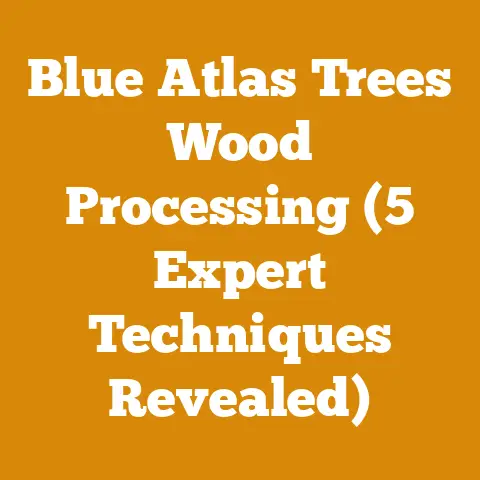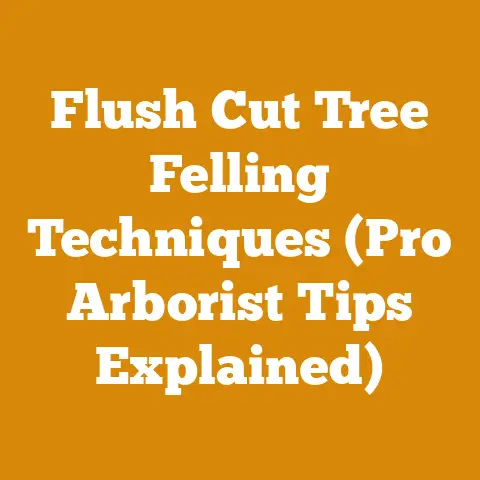How Do You Use a Stump Grinder? (5 Pro Tips for Efficient Grinding)
Ah, the satisfying thrum of a well-tuned engine, the smell of freshly ground wood – there’s nothing quite like it! Let’s talk about stump grinding. I have spent countless hours wrestling with stubborn stumps, transforming eyesores into usable space. Trust me, I know the frustrations (and the triumphs!) that come with this task. But over the years, I’ve honed my techniques, learned from my mistakes (and there were plenty!), and developed a few pro tips that can make your stump grinding endeavors far more efficient and, dare I say, enjoyable.
Key Takeaways:
- Safety First: Always prioritize personal protective equipment (PPE) and clear the work area.
- Preparation is Key: Properly assess the stump, remove debris, and plan your grinding strategy.
- Master the Technique: Use the sweeping method, control the grinding depth, and avoid aggressive cuts.
- Maintain Your Machine: Regularly inspect and sharpen teeth, check fluid levels, and follow manufacturer’s recommendations.
- Optimize for Efficiency: Consider stump size, soil conditions, and machine power for the best approach.
How Do You Use a Stump Grinder? 5 Pro Tips for Efficient Grinding
Stump grinding can seem daunting, but with the right approach, it’s a manageable task. I will walk you through my tried-and-true methods.
Understanding Stump Grinders
Before diving into the “how,” let’s understand the “what.” Stump grinders are powerful machines designed to remove tree stumps by chipping away at the wood using a rotating cutting wheel equipped with hardened teeth. They come in various sizes and power levels, from smaller, homeowner-grade models to large, professional-grade machines.
Types of Stump Grinders
- Walk-Behind Stump Grinders: These are the most common type for residential use. They are relatively compact and maneuverable, making them suitable for smaller stumps and tighter spaces.
- Tow-Behind Stump Grinders: These are larger and more powerful than walk-behind models. They are typically towed behind a truck or tractor and are better suited for larger stumps and commercial applications.
- Self-Propelled Stump Grinders: These offer the best of both worlds: power and maneuverability. They are self-powered and can be easily moved around the job site.
- Hydraulic Stump Grinders: These are attachments that connect to skid steers or other heavy equipment. These are very powerful and are mostly used by professionals.
Choosing the Right Stump Grinder
The best stump grinder for you depends on the size and number of stumps you need to remove, as well as your budget and experience level. For occasional use on small to medium-sized stumps, a walk-behind model is often sufficient. For larger projects or commercial applications, a tow-behind or self-propelled model may be necessary.
Pro Tip #1: Safety is Paramount
I cannot stress this enough: safety must always be your top priority when operating a stump grinder. These machines are powerful and can cause serious injury if not used properly.
Essential Personal Protective Equipment (PPE)
- Eye Protection: Wear safety glasses or a face shield to protect your eyes from flying debris. Trust me, you don’t want a wood chip in your eye.
- Hearing Protection: Stump grinders are loud. Use earplugs or earmuffs to prevent hearing damage.
- Hand Protection: Wear heavy-duty work gloves to protect your hands from cuts and abrasions.
- Foot Protection: Wear steel-toed boots to protect your feet from falling objects and the cutting wheel.
- Leg Protection: Wear chaps or sturdy pants to protect your legs from flying debris.
Clearing the Work Area
Before starting the grinder, thoroughly clear the area around the stump of any rocks, debris, or other obstacles. These objects can become projectiles when struck by the cutting wheel. Also, make sure no underground utilities are present. A call to 811 before you dig can save a life.
Maintaining a Safe Distance
Keep bystanders, especially children and pets, at a safe distance from the work area. A good rule of thumb is at least 50 feet.
Emergency Procedures
Familiarize yourself with the stump grinder’s emergency stop procedures before you start working. Know how to quickly shut down the machine in case of an accident.
Pro Tip #2: Preparation is Half the Battle
Proper preparation can significantly improve your efficiency and the quality of your stump grinding job.
Assessing the Stump
Carefully examine the stump to determine its size, shape, and the type of wood. This will help you choose the right grinding technique and adjust the machine’s settings accordingly. Also, check for any hidden obstacles, such as rocks or metal objects embedded in the stump.
Removing Debris
Use a shovel, rake, or broom to remove any loose dirt, rocks, or debris from around the base of the stump. This will prevent the cutting wheel from becoming damaged and improve the grinding process.
Exposing the Root Flare
The root flare is the area where the roots begin to branch out from the stump. Exposing the root flare will allow you to grind the stump below ground level, which is essential for planting grass or other vegetation.
Planning Your Attack
Before starting the grinder, take a moment to plan your grinding strategy. Determine the best angle of attack and the sequence in which you will grind the stump. This will help you avoid wasting time and energy.
Pro Tip #3: Mastering the Grinding Technique
The key to efficient stump grinding is to use the right technique. Here’s what I’ve learned over the years:
The Sweeping Method
The sweeping method involves moving the cutting wheel back and forth across the stump in a smooth, controlled motion. This technique allows you to remove a thin layer of wood with each pass, which is more efficient than trying to remove large chunks at once.
Controlling the Grinding Depth
Avoid trying to grind too deep with each pass. A shallow, controlled cut is more efficient and reduces the risk of damaging the cutting wheel.
Avoiding Aggressive Cuts
Aggressive cuts can cause the stump grinder to vibrate excessively, which can be tiring and potentially dangerous. Instead, focus on making smooth, controlled cuts.
Working in Layers
Grind the stump down in layers, starting at the top and working your way down. This will help you maintain control of the machine and prevent the cutting wheel from binding.
Overlapping Passes
Overlap each pass slightly to ensure that you remove all of the wood.
Grinding Below Ground Level
To properly remove the stump, you’ll need to grind it down below ground level. This will allow you to plant grass or other vegetation in the area. I generally aim to go at least 6 inches below the surface.
Pro Tip #4: Maintenance Matters
A well-maintained stump grinder is a happy stump grinder (and a happy operator!). Regular maintenance will not only extend the life of your machine but also improve its performance and safety.
Inspecting the Teeth
The cutting teeth are the heart of the stump grinder. Regularly inspect them for wear and damage. Sharpen or replace teeth as needed. A dull tooth is not only inefficient but can also put undue stress on the machine.
Sharpening the Teeth
Sharpening the teeth is essential for maintaining optimal performance. Use a specialized grinding tool to sharpen the teeth at the correct angle. I usually sharpen my teeth after every 4-5 hours of use.
Checking Fluid Levels
Regularly check the engine oil, hydraulic fluid, and coolant levels. Top up as needed.
Cleaning the Machine
After each use, clean the stump grinder to remove any dirt, debris, or wood chips. This will help prevent corrosion and ensure that the machine operates smoothly.
Lubricating Moving Parts
Lubricate all moving parts, such as the bearings and pivot points, with a high-quality grease. This will help reduce friction and wear.
Following Manufacturer’s Recommendations
Always follow the manufacturer’s recommendations for maintenance and service. This will help you keep your stump grinder in top condition.
Pro Tip #5: Optimizing for Efficiency
Getting the most out of your stump grinder requires understanding the factors that affect its performance and adjusting your approach accordingly.
Stump Size and Type
Larger stumps will require more time and effort to grind than smaller stumps. Hardwood stumps, such as oak or maple, will be more difficult to grind than softwood stumps, such as pine or fir.
Soil Conditions
The type of soil around the stump can also affect the grinding process. Rocky or sandy soil can dull the cutting teeth more quickly. Wet soil can make it difficult to maneuver the machine.
Machine Power
The power of your stump grinder will determine how quickly and efficiently you can grind stumps. A more powerful machine will be able to handle larger stumps and tougher wood.
Grinding Wheel Size
The size of the grinding wheel will affect the depth and width of each cut. A larger wheel will allow you to remove more wood with each pass.
Tooth Configuration
The configuration of the cutting teeth can also affect the grinding process. Some teeth are designed for aggressive cutting, while others are designed for smoother cutting.
Adjusting Grinding Speed
Experiment with different grinding speeds to find the optimal setting for the stump you are working on. A slower speed may be necessary for harder wood or larger stumps.
Real-World Scenarios and Case Studies
Let me share a few stories from my own experience that highlight the importance of these pro tips.
The Case of the Hidden Rock
I was once grinding a large oak stump in a customer’s backyard when I hit something hard. I immediately stopped the machine and inspected the area. It turned out there was a large rock buried in the stump. If I hadn’t been paying attention, I could have seriously damaged the cutting wheel or even injured myself. This reinforces the importance of clearing the work area and assessing the stump before starting.
The Tale of the Dull Teeth
I remember a time when I was trying to grind a series of pine stumps with dull teeth. The machine was vibrating excessively, and I was making very little progress. After wasting several hours, I finally decided to sharpen the teeth. The difference was remarkable! The machine ran smoother, and I was able to grind the stumps much faster. This taught me the importance of maintaining the cutting teeth.
The Lesson of the Overzealous Cut
Early in my career, I tried to remove a large section of a stump with a single, aggressive cut. The machine bogged down, and the cutting wheel got stuck. It took me a long time to free the wheel, and I learned a valuable lesson about the importance of controlled cuts.
Global Considerations
It’s important to remember that stump grinding practices can vary depending on the region and the types of trees that are common in that area. For example, in some parts of the world, it’s common to burn stumps instead of grinding them. In other areas, stumps are left to decompose naturally.
Adapting to Local Conditions
When working in a new area, take the time to learn about the local conditions and adjust your techniques accordingly.
Considering Environmental Factors
Be mindful of the environmental impact of your stump grinding activities. Avoid grinding stumps near waterways or sensitive areas. Dispose of wood chips properly.
Conclusion: From Eyesore to Opportunity
Stump grinding is more than just removing an obstacle; it’s about reclaiming space and creating new possibilities. Whether you’re a homeowner looking to improve your property or a professional landscaper, mastering the art of stump grinding can be a valuable skill.
By following these pro tips, you can grind stumps efficiently, safely, and effectively. Remember to prioritize safety, prepare your work area, master the grinding technique, maintain your machine, and optimize for efficiency. With a little practice and patience, you’ll be transforming unsightly stumps into beautiful, usable spaces in no time.
Now, go out there and conquer those stumps! And remember, a well-maintained stump grinder is your best friend in this endeavor. Consider this an investment in the longevity of your equipment and the quality of your work.
Call to Action:
- Ready to tackle your stump grinding project? Review these tips before you start.
- Need a new stump grinder or replacement parts? Check out our recommended tools and equipment.
- Have any questions or tips of your own? Share them in the comments below!






